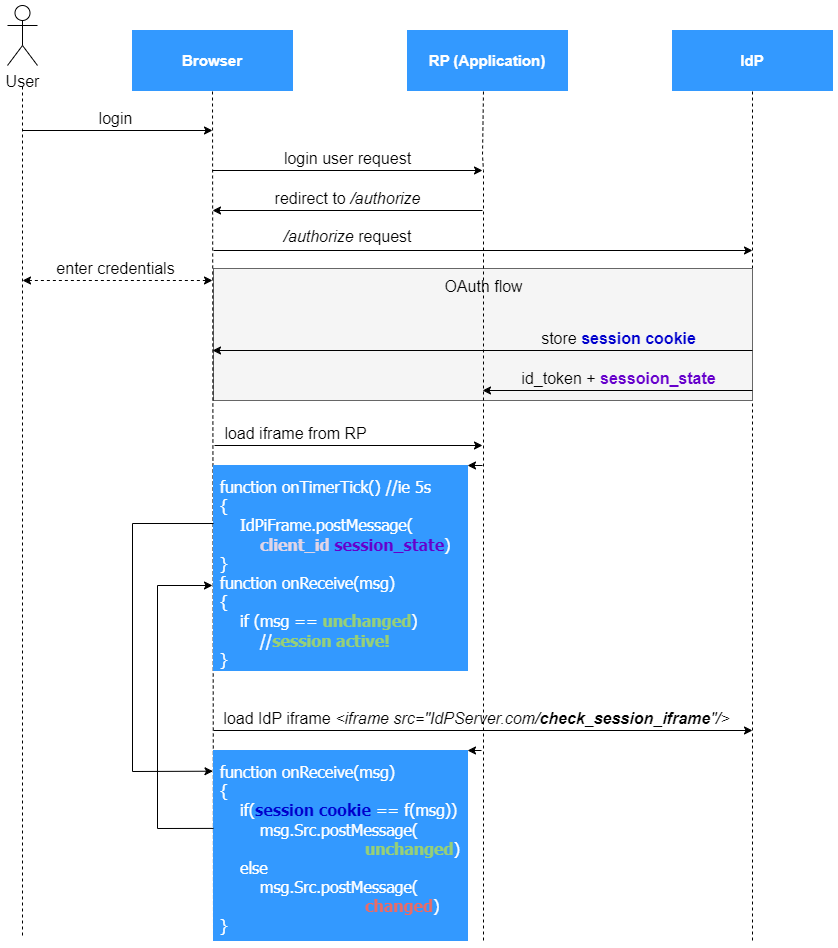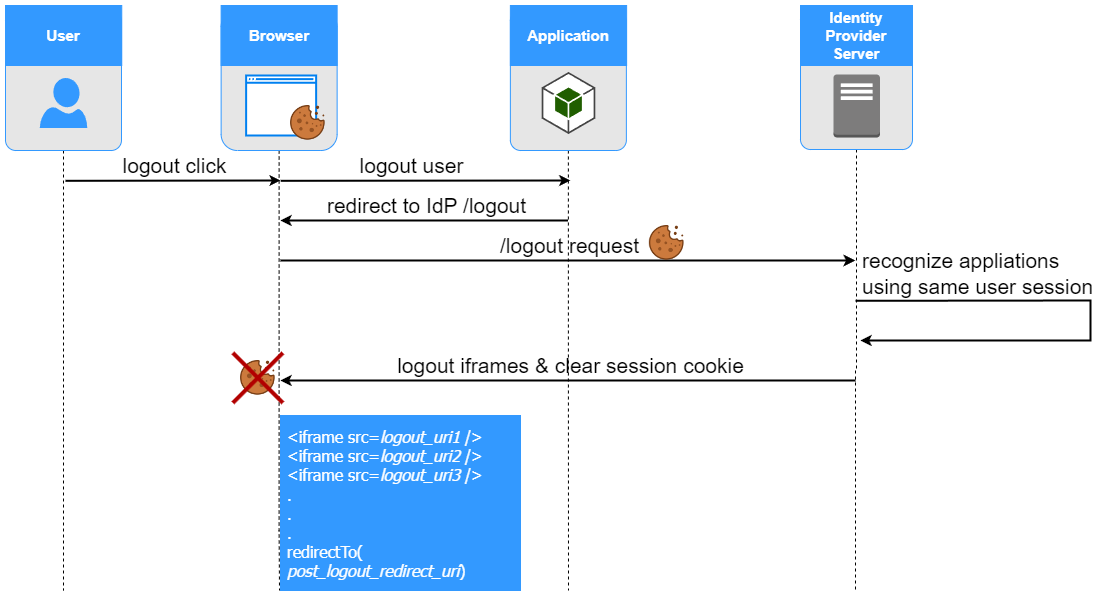OpenId Connect Session Management
OpenId-Connect session represents the authenticated user context, maintained between Applications and Identity Provider Server. Session enables applications to provide seamless authentication experience by:
-
Avoiding frequent authentication – As long as there is an active session available, application can acquire new access/id tokens from Identity Provider Server, without user being asked to re-authenticate.
-
Enabling Single sign-on (SSO) - SSO enables multiple applications launched in the same web browser and working under the same Identity Provider Server to share the same user session. Once user logs-in into single application, other applications, can be used, without user being asked to re-authenticate.
-
Synchronizing user context across applications - From application perspective, it is important to know if it works in the context of logged-in user or not. Since identity management is delegated to Identity Provider Server, application needs to be synchronized with Identity Provider. Moreover, it needs to react on user session events. It becomes challenging, in SSO scenarios, where multiple applications, use the same user session. Some actions like user logout, password reset or users account deletion requires all other applications using current session to be informed.
Additionally, Identity Provider servers usually provides administrator option to revoke all user’s sessions. It can be used if user device was lost or stolen to protect against unauthorized access and malicious usage.
In this article I will describe how applications determine user session status, considering SSO scenarios. I will focus on methods provided by OpenId Connect. For applications requiring custom solutions, described methods can be used as a foundation.
Table of contents
Terminology
To keep this article consistent, I will use following naming for OpenId Connect parties
RP – Relaying Party, Client Application
IdP - Authorization Server, Identity Provider Server
additionally
SSO scope – RP’s registered under common IdP, able to utilize the same user session.
Determining session status
Applications usually provide different functionalities depending if running in the context of logged-in user or not. Below solutions enables RPs to determine current session status.
Polling Based Solutions
Polling, in general, is a way to determine a status of an asset, by actively, cyclically, checking its value. In the context of OpenId Connect and session management, polling solutions are based on cyclic requests to IdP to gather latest user session status.
Solution 1 - check_session_iframe endpoint
check_session_iframe endpoint is described in OpenId Connect Session-related specs. It requires RP to load JavaScript code from IdP. Loaded code validates current session state.

session_state
In response to initial /authorize endpoint request, IdP returns session_state parameter. Additionally, after successful authentication, IdP stores a session cookie in user’s browser.
loading IdP code
RP application, launched in the browser, should include an iframe element that loads content from IdP’s /check_session_iframe endpoint. Loaded content is a JavaScript function, which validates if user session is active or not. Validation is based on session_state and clientId provided by RP as arguments. Function calculates expected session cookie value and compares it with actual session cookie, stored in the browser. Once expected and actual session cookies are equal, function returns unchanged (which indicates active session), or changed. This logic can be expressed by following condition:
f(session_state, client_id) == session_cookie ? unchanged : changed
Cyclic execution
IdP validation function can be executed periodically by RP, to achieve polling mechanism. OpenId Connect documentation recommends to load anther iframe directly from RP, that will be solely responsible for cyclically triggering validation.
Network traffic
Network traffic needed to check session status is very limited. Once IdP iframe is loaded, session can be validated using loaded JavaScript code only - with no IdP interaction. That can be considered as main advantage of check_session_iframe-based solution.
Limitation: Iframe and 3rd Party Cookies
Iframe based has a serious limitation in modern, security-oriented browsers. OpenId Connect documentation stands:
Note that at the time of this writing, some User Agents (browsers) are starting to block access to third-party content by default to block some mechanisms used to track the End-User’s activity across sites. Specifically, the third-party content being blocked is website content with an origin different that the origin of the focused User Agent window. Site data includes cookies and any web storage APIs (sessionStorage, localStorage, etc.).
For security reasons more and more browsers don’t allow cross domain cookies access. Since RP loads IdP iframe, it requires an access to the session cookie, which belongs to IdP.
Following list presents popular browser support for 3rd party cookies.
- Safari – not supported
- Google Chrome– planning to finish support in 2024
- Firefox – third party cookies are blocked by default
Some IdPs allows to configure a custom domain, common for RP and IdP. Having IdP and RP in the same domain makes cookie access possible, regardless 3-rd party cookies restrictions. For instance, IdP can be accessed at https://login.example.com while app is hosted on https://example.com.
Solution 2 - /authorize endpoint polling
OpenId Connect specification describes /authorize endpoint. It is used to initiate authentication flow. /authorize endpoint accepts prompt parameter. In case prompt parameter set to none, IdP checks session cookie, provided within the request. If attached cookie represents an active session, user will not be asked to enter credentials. If provided session cookie is invalid or associated user session is no longer active, user will be asked to enter login credentials.
In the context of authentication /authorize endpoint call initiates grant flow, which eventually returns id_token to the application. By calling /authorize endpoint cyclically, application is updated with latest user-related claims, stored in id_token. It can be an advantage, when other application modifies user claims in the meantime.
Some IdPs providers, supports rolling session. Session expiration can be postponed every time, when corresponding session cookie is used to acquire new id_token. It allows to keep the session alive longer, when it is actively used by RP.
Iframe for seamless experience
To provide seamless user experience /authorize endpoint can be called using iframe. Thanks to iframe, user is not redirected to /authorize page and back on every call. Instead, call can be done “in the background”- without users notice.
Limitation 1: Iframe and 3rd Party Cookies
In order to validate user session IdP requires an access to session cookie stored in browser. Considering strict 3-rd party policy, it might not be possible, when IdP was called from other domain’s iframe.
Some IdPs allows to configure a custom domain, common for RP and IdP. Having IdP and RP in the same domain makes cookie access possible, regardless 3-rd party cookies restrictions. For instance, IdP can be accessed at https://login.example.com while app is hosted on https://example.com.
Limitation 2: Iframe and Clickjacking protection
Iframe usage leads to some more security concerns than just 3rd party cookies, especially in the context of authentication and authorization. Iframe element can be used to perform clickjacking attack. Clickjacking is very well described in OWASP and Auth0 articles. To prevent the attack, a X-Frame-Options: DENY header can be added to http header, to make sure, browser will not allow to load th login page inside iframe.
As long as there is active user session, /authorize endpoint can be successfully called from iframe. Once user session expires, IdP tries to redirect next /authorize call to the login page. Since login page likely includes X-Frame-Options: DENY header and it is called from iframe, redirect will fail.
As a workaround some IdP providers recommend following solution expressed in pseudo-code
try
{
CallAutorizeUsingIFrame()
}
catch
{
CallAuthorizeUsingRedirect()
}
In example above /authorize endpoint is called using redirect, only when iframe call fails. Assuming failure is caused by expired session and attempt to display login page in iframe, user will be redirected to login page outside the iframe in catch block. After successful login new session is established and /authorize can be called from iframe again.
Besides that, some IdPs allows to configure X-Frame-Options header value if needed, however it should be considered as “unsafe mode”.
Limitation 3: API Rate Limits
/authorize endpoint polling should be considered in the context of IdP API rate limits. If polling interval is too short, API call limit can be reached.
Logout Based Solutions
RPs use logout-based solutions to track active user session by listening on logout event. RP provides an endpoint that can be called by IdP, in case logout event occurred in other application, which uses the same user session.
RP logout is initiated by calling IdP’s /logout endpoint.
IdP clears session cookie on logout request. Moreover, IdP can spread logout information to other RPs using
- Front-Channel Logout
- Back-Channel Logout
Solution 3 - Front-Channel Logout
Front-Channel Logout is described in OpenId Connect documentation. Front-Channel Logout procedure is initiated by calling IdP’s /logout endpoint. IdP tracks RPs and their active sessions. Based on session cookie, provided within /logout request IdP finds all applications using corresponding session. Once IdP receives logout request from RP, logout event is spread to other RPs (which uses the same session), by calling their frontchannel_logout_uri endpoints via front channel. (All RPs need to be configured with frontchannel_logout_uri in IdP client registration properties).
RPs can adjust their internal state and clean information associated with logged-in user, after receiving front-channel logout request.
Front-channel logout mechanism utilizes iframes. IdP loads a website containing iframes in response to /logout request. Each iframe src corresponds with single frontchannel_logout_uri. Once all RPs are notified IdP redirects user to post_logout_redirect_uri specified in initial /logout request parameters.

Limitation 1: Iframe and 3rd Party Cookies
Main limitation of frontend logout solutions is, again, related with third-party cookies. Since frontchannel_logout_uri is iframed and called on IdP, there might be some limitations with access to RP’s cookies.
Limitation 2: URI fragment component
Additionally, frontchannel_logout_uri must not contains fragment component (like example.com#logout). Many SPA frameworks uses fragment components for routing.
Solution 4 - Back-Channel Logout
Back-Channel Logout is described in OpenId Connect documentation. Logout information is sent to all RPs using current browser session via back-channel. In response to /logout request IdP creates a logout_token and sends it via back-channel POST call to RP’s /backchannel_logout_uri. backchannel_logout_uri is associated with RP in IdP client registration properties.
logout_token should be validated by RP. It is critical to compare logout_token properties (like sub) with current id_token and verify if logout request corresponds with currently logged in user.
Once all RPs are notified IdP redirects user to post_logout_redirect_uri specified in initial /logout request parameters.
Not all IdPs supports Back-Channel logout. If Back-Channel is supported, backchannel_logout_supported property is visible in IdP discovery endpoint.